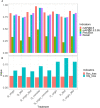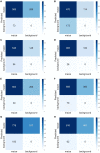Maize plant detection using UAV-based RGB imaging and YOLOv5
- PMID: 38239212
- PMCID: PMC10794460
- DOI: 10.3389/fpls.2023.1274813
Maize plant detection using UAV-based RGB imaging and YOLOv5
Abstract
In recent years, computer vision (CV) has made enormous progress and is providing great possibilities in analyzing images for object detection, especially with the application of machine learning (ML). Unmanned Aerial Vehicle (UAV) based high-resolution images allow to apply CV and ML methods for the detection of plants or their organs of interest. Thus, this study presents a practical workflow based on the You Only Look Once version 5 (YOLOv5) and UAV images to detect maize plants for counting their numbers in contrasting development stages, including the application of a semi-auto-labeling method based on the Segment Anything Model (SAM) to reduce the burden of labeling. Results showed that the trained model achieved a mean average precision (mAP@0.5) of 0.828 and 0.863 for the 3-leaf stage and 7-leaf stage, respectively. YOLOv5 achieved the best performance under the conditions of overgrown weeds, leaf occlusion, and blurry images, suggesting that YOLOv5 plays a practical role in obtaining excellent performance under realistic field conditions. Furthermore, introducing image-rotation augmentation and low noise weight enhanced model accuracy, with an increase of 0.024 and 0.016 mAP@0.5, respectively, compared to the original model of the 3-leaf stage. This work provides a practical reference for applying lightweight ML and deep learning methods to UAV images for automated object detection and characterization of plant growth under realistic environments.
Keywords: UAV remote sensing; YOLOv5 application; crop scouting; deep learning; plant detection model.
Copyright © 2024 Lu, Nnadozie, Camenzind, Hu and Yu.
Conflict of interest statement
The authors declare that the research was conducted in the absence of any commercial or financial relationships that could be construed as a potential conflict of interest. The author(s) declared that they were an editorial board member of Frontiers, at the time of submission. This had no impact on the peer review process and the final decision.
Figures








Similar articles
-
An improved algorithm based on YOLOv5 for detecting Ambrosia trifida in UAV images.Front Plant Sci. 2024 May 10;15:1360419. doi: 10.3389/fpls.2024.1360419. eCollection 2024. Front Plant Sci. 2024. PMID: 38799099 Free PMC article.
-
ASG-YOLOv5: Improved YOLOv5 unmanned aerial vehicle remote sensing aerial images scenario for small object detection based on attention and spatial gating.PLoS One. 2024 Jun 3;19(6):e0298698. doi: 10.1371/journal.pone.0298698. eCollection 2024. PLoS One. 2024. PMID: 38829850 Free PMC article.
-
YOLOv5_mamba: unmanned aerial vehicle object detection based on bidirectional dense feedback network and adaptive gate feature fusion.Sci Rep. 2024 Sep 27;14(1):22396. doi: 10.1038/s41598-024-73241-x. Sci Rep. 2024. PMID: 39333360 Free PMC article.
-
A Novel Network Framework on Simultaneous Road Segmentation and Vehicle Detection for UAV Aerial Traffic Images.Sensors (Basel). 2024 Jun 3;24(11):3606. doi: 10.3390/s24113606. Sensors (Basel). 2024. PMID: 38894397 Free PMC article.
-
Intelligent agriculture: deep learning in UAV-based remote sensing imagery for crop diseases and pests detection.Front Plant Sci. 2024 Oct 24;15:1435016. doi: 10.3389/fpls.2024.1435016. eCollection 2024. Front Plant Sci. 2024. PMID: 39512475 Free PMC article. Review.
Cited by
-
YOLOv8s-Longan: a lightweight detection method for the longan fruit-picking UAV.Front Plant Sci. 2025 Jan 22;15:1518294. doi: 10.3389/fpls.2024.1518294. eCollection 2024. Front Plant Sci. 2025. PMID: 39911656 Free PMC article.
-
Comparison of YOLO-based sorghum spike identification detection models and monitoring at the flowering stage.Plant Methods. 2025 Feb 17;21(1):20. doi: 10.1186/s13007-025-01338-z. Plant Methods. 2025. PMID: 39962585 Free PMC article.
-
Unmanned aerial vehicle image detection of maize-YOLOv8n seedling leakage.Front Plant Sci. 2025 May 23;16:1569229. doi: 10.3389/fpls.2025.1569229. eCollection 2025. Front Plant Sci. 2025. PMID: 40487215 Free PMC article.
-
Enhanced recognition and counting of high-coverage Amorphophallus konjac by integrating UAV RGB imagery and deep learning.Sci Rep. 2025 Feb 22;15(1):6501. doi: 10.1038/s41598-025-91364-7. Sci Rep. 2025. PMID: 39987316 Free PMC article.
-
Full-time sequence assessment of okra seedling vigor under salt stress based on leaf area and leaf growth rate estimation using the YOLOv11-HSECal instance segmentation model.Front Plant Sci. 2025 Aug 14;16:1625154. doi: 10.3389/fpls.2025.1625154. eCollection 2025. Front Plant Sci. 2025. PMID: 40894513 Free PMC article.
References
-
- Bochkovskiy A., Wang C.-Y., Liao H.-Y. M. (2020). YOLOv4: optimal speed and accuracy of object detection. arXiv preprint arXiv:2004.10934. doi: 10.48550/ARXIV.2004.10934 - DOI
-
- Carciochi W. D., Schwalbert R., Andrade F. H., Corassa G. M., Carter P., Gaspar A. P., et al. . (2019). Soybean seed yield response to plant density by yield environment in north america. Agron. J. 111, 1923–1932. doi: 10.2134/agronj2018.10.0635 - DOI
-
- Casuccio L., Kotze A. (2022). Corn planting quality assessment in very high-resolution RGB UAV imagery using Yolov5 and Python. AGILE: GIScience Ser. 3, 1–9. doi: 10.5194/agile-giss-3-28-2022 - DOI
-
- Du D., Zhu P., Wen L., Bian X., Lin H., Hu Q., et al. . (2019). VisDrone-DET2019: the vision meets drone object detection in image challenge results, in: 2019 IEEE/CVF international conference on computer vision workshop (ICCVW). Presented at 2019 IEEE/CVF Int. Conf. Comput. Vision Workshop (ICCVW) pp, 213–226. doi: 10.1109/ICCVW.2019.00030 - DOI
LinkOut - more resources
Full Text Sources

